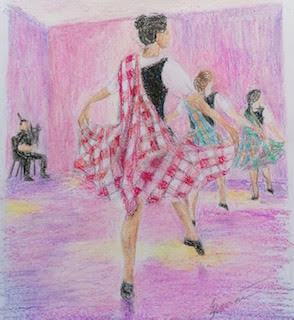Introduction
‘Highland dancing’ covers a range of traditional solo Scottish dances including the true Highland dances (Highland Fling, Sword Dance, Seann Triubhas, Strathspey, Highland Reel, and Reel of Tulloch or ‘Hullachan’) and a number of ‘National dances’.
These latter are generally ‘softer’ and more balletic in style than the true Highland dances. Both Highland and National dances are performed at Highland dance competitions and the most famous are two true Highland dances – the Highland Fling and the Sword Dance (yes you really do dance over swords!)
The Make-up of the Dances
Each Highland or National dance is made up of a number of steps and the length of the dance is determined by how many steps the dancer executes. For example you might do a 4 step Highland Fling or a 6 step Highland Fling. Rarely, if ever, does anyone do more than 6 steps!
Each step is usually made up of a logical arrangement of parts. For example a step may be in two halves with the second half a mirror image of the first; or in quarters with the first quarter mirrored by the second quarter and the 3rd and 4th quarters a repeat of the 1st and 2nd. Most National dances also have a ‘break’ which forms the end part of the majority of steps (or half steps).

Costume
Costume can be a good guide to what ‘type’ of dance is being danced, as at competitions (and in most performances) dancers will wear specific types of costume for specific dances.
For true Highland dances both men and ladies wear kilts, the men in shirts, bow ties, waist coats and black jackets, and the ladies in velvet waistcoats either long sleeved or sleeveless with a white ‘Highland’ blouse. For National dances, the men may still wear kilts and jackets, or may wear tartan trousers and a Montrose jacket (jacket with a high neck) and jabo. For most National dances ladies wear an ‘Aboyne’ outfit (also referred to as a ‘national costume’ or ‘Flora’). This consists of a full, roughly knee-length skirt, a wide sash across the back, pinned on the shoulder, a velvet sleeveless waistcoat with fancy buttons and a white ‘national’ blouse. However, for a couple of the National dances which are very ‘Highland’ in style, women wear kilt outfits.
Two National dances are an exception to this dress rule – the Irish Jig and the Sailor’s Hornpipe. For the Irish Jig red and green (non tartan) costumes are worn – for example a green, sleeveless waistcoat with a white blouse and a green skirt with red lining for a lady. For the Sailor’s Hornpipe both men and ladies wear sailors outfits (usually blue and white).

Learning Highland Dancing
If you are interested in learning Highland dancing, New Scotland runs a Beginners Highland class as well as a wide-ranging Intermediate Highland class which caters for anyone who has done a year or more of Highland dancing.
